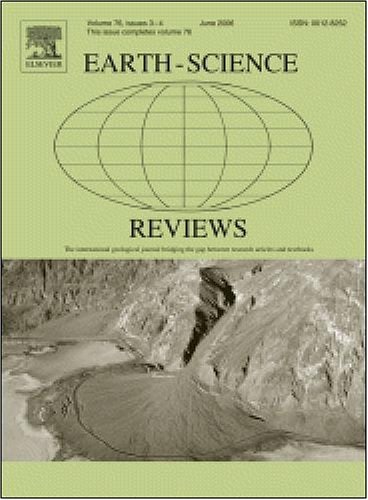Diagenesis of hydrocarbon-seep carbonates: Common patterns, divergent pathways and conceptual pitfalls
IF 10
1区 地球科学
Q1 GEOSCIENCES, MULTIDISCIPLINARY
引用次数: 0
Abstract
Authigenic carbonates formed at marine hydrocarbon seeps are an important component of carbon cycling at continental margins. Ancient hydrocarbon-seep deposits serve as archives of the evolution of chemosynthesis-based ecosystems, past pore-water chemistry, and the tectonic architecture and geological history of their host sedimentary basins. However, while modern and ancient seep deposits share many similarities, they also show notable differences in their petrological and geochemical characteristics. The insufficient understanding of the origin of these differences limits our ability to address fundamental questions about the palaeoecology of seep-specialised communities, the geological evolution of seep-hosting plate margins, and secular changes in the composition of the seeping fluids and/or seawater. Here, we critically evaluate the carbon, oxygen and strontium isotope signatures, as well as selected minor and trace element systematics of ancient seep carbonates. We identify distinctive, recurring patterns and discuss them in the context of current understanding of the controls on carbonate authigenesis and alteration in marine pore waters. The precipitation of seep carbonates mostly from sediment pore waters at the transition between the sulphate reduction and methanogenic zones favours the preservation of primary textural and geochemical characteristics. However, in this anoxic, spatially and temporarily complex setting, the concentrations of many minor and trace elements, including the refractory lithophile elements, are subject to increased mobility during fluid-rock interactions, mineral transformations and organic matter decomposition. This mobility complicates their traditional use as indicators of post-depositional alteration, laboratory artefacts, or original mineralogies. The high concentrations of strontium with non-marine 87Sr/86Sr ratios that may be introduced with the seeping fluids offer insights into the fluid sources and basement characteristics, but also limit the utility of Sr isotope stratigraphy for dating seep deposits. A negative correlation between the δ13C and δ18O values, commonly observed in microcrystalline phases, most likely reflects the continuous cementation of seep carbonates during burial in the methanogenic zone. This process is driven by methanogenesis-associated aluminosilicate weathering, releasing 13C-enriched and 18O-depleted fluids. Another common pattern, the narrow clustering of strongly negative δ18O signals, appears to record selective δ18O resetting during fluid-dominated post-depositional alteration. The observed increased δ13C values of seep carbonates during parts of the Paleozoic and Mesozoic may be associated with the secular changes in the dissolved inorganic carbon concentration of seawater, while the role of other controls remains unclear. Our work provides a timely synthesis of the constraints on recognizing the primary and post-depositional features of ancient seep deposits, offering a framework for interpreting their geochemical systematics in terms of specific diagenetic processes.
渗烃碳酸盐岩成岩作用:共同模式、不同路径和概念缺陷
海相油气渗漏形成的自生碳酸盐是大陆边缘碳循环的重要组成部分。古烃类渗漏矿床是以化学合成为基础的生态系统演化、过去孔隙水化学以及其所在沉积盆地的构造结构和地质历史的档案。现代和古代渗漏矿床有许多相似之处,但在岩石学和地球化学特征上也存在显著差异。对这些差异的成因认识不足,限制了我们解决以下基本问题的能力:专门的渗漏群落的古生态学、容纳渗漏的板块边缘的地质演化,以及渗漏流体和/或海水成分的长期变化。在此,我们对古渗碳酸盐岩的碳、氧、锶同位素特征以及选定的微量元素和微量元素系统进行了批判性评价。我们发现了独特的、反复出现的模式,并在当前对海洋孔隙水中碳酸盐自生和蚀变控制的理解的背景下讨论了它们。在硫酸盐还原带和产甲烷带的过渡阶段,沉积孔隙水主要析出渗漏碳酸盐,有利于原始结构和地球化学特征的保存。然而,在这种缺氧、空间和暂时复杂的环境中,许多微量元素和微量元素(包括难熔亲石元素)的浓度在流体-岩石相互作用、矿物转化和有机物分解过程中受到流动性增强的影响。这种流动性使它们作为沉积后蚀变、实验室人工制品或原始矿物学指标的传统用途复杂化。随着渗流流体可能引入的非海相87Sr/86Sr比值的高浓度锶有助于了解流体来源和基底特征,但也限制了Sr同位素地层学对渗流矿床定年的应用。δ13C值与δ18O值呈负相关,在微晶相中较为常见,这很可能反映了产甲烷带埋藏过程中渗漏碳酸盐的连续胶结作用。这一过程是由甲烷生成相关的铝硅酸盐风化作用驱动的,释放出富含13c和缺乏18o的流体。另一种常见的模式是强负δ18O信号的窄聚类,似乎记录了沉积后流体主导的蚀变过程中δ18O的选择性重置。古生代和中生代部分时期渗漏碳酸盐δ13C值的升高可能与海水溶解无机碳浓度的长期变化有关,其他控制因素的作用尚不清楚。我们的工作及时综合了识别古渗储的原始和沉积后特征的制约因素,为从特定成岩过程角度解释其地球化学系统提供了一个框架。
本文章由计算机程序翻译,如有差异,请以英文原文为准。
求助全文
约1分钟内获得全文
求助全文
来源期刊

Earth-Science Reviews
地学-地球科学综合
CiteScore
21.70
自引率
5.80%
发文量
294
审稿时长
15.1 weeks
期刊介绍:
Covering a much wider field than the usual specialist journals, Earth Science Reviews publishes review articles dealing with all aspects of Earth Sciences, and is an important vehicle for allowing readers to see their particular interest related to the Earth Sciences as a whole.
 求助内容:
求助内容: 应助结果提醒方式:
应助结果提醒方式:


